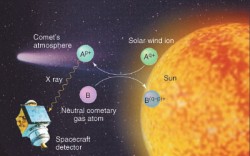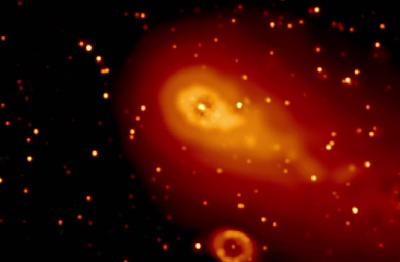[/caption]Things appeared to get a little strange in the field of X-ray astronomy when the NASA/ESA ROSAT observatory started seeing emissions from a series of comets. This discovery in 1996 was a conundrum; how could X-rays, more commonly associated with hot plasmas, be produced by some of the coldest bodies in the Solar System? In 2005, NASA’s Swift observatory was launched to look out for some of the most energetic events in the observable Universe: gamma-ray bursts (GRBs) and supernovae. But in the last three years, Swift has also proven itself to be an expert comet hunter.
If X-rays are usually emitted by multi-million Kelvin plasmas, how can X-rays possibly be generated by comets composed of ice and dust? It turns out there is an interesting quirk as comets interact with the solar wind within 3AU from the solar surface, allowing instrumentation designed to observe the most violent explosions in the Universe to also study the most elegant objects closer to home…
“It was a big surprise in 1996 when the NASA-European ROSAT mission showed that comet Hyakutake was emitting X-rays,” said Dennis Bodewits, NASA Postdoctural Fellow at the Goddard Space Flight Centre. “After that discovery, astronomers searched through ROSAT archives. It turns out that most comets emit X-rays when they come within about three times Earth’s distance from the sun.” And it must have been a very big surprise for researchers who assumed ROSAT could only be used to glimpse the transient flash of a GRB or supernova, possibly spawning the birth of black holes. Comets simply did not feature in the design of this mission.
However, since the launch of another GRB hunter in 2005, NASA’s Swift Gamma-ray Explorer has spotted 380 GRBs, 80 supernovae and… 6 comets. So how can a comet possibly be studied by equipment intended for something so radically different?
As comets begin their death-defying sunward orbit, they heat up. Their frozen surfaces begin to blast gas and dust into space. Solar wind pressure causes the coma (the comet’s temporary atmosphere) to eject gas and dust behind the comet, away from the Sun. Neutral particles will be carried away by solar wind pressure, whereas charged particles will follow the interplanetary magnetic field (IMF) as an “ion tail”. Comets therefore can often be seen with two tails, a neutral tail and an ion tail.
This interaction between the solar wind and comet has another effect: charge exchange.

Charge exchange can occur in any system where a hot stream of ions interact with a cooler neutral gas. Using missions such as Swift to study the interaction of comets with the solar wind can provide a valuable laboratory for scientists to understand otherwise confusing X-ray emissions from other systems.
Source: Physorg.com


Hmmm… Not my particular area of expertise, but I can’t say I find it surprising at all that the solar wind interacts with cometary emissions to produce x-rays. Not trying to be a smart arse at all, but I just can’t see why that would be a surprising finding!
To astrofiend,
If we could detect x-rays from comets, then it will be easier to search for them…. Meaning there could be a map of most comets that cross Earth’s orbit, or how far their orbit are.
Indeed. Other astrophysicists have noted (A) electrostatic charging of the comet nucleus, (B) folding of the interplanetary magnetic field into the tail of the comet, and (C) a cometary current system with a total current exceeding 10^8A.
DA Mendis noted that Soviet VEGA 2 spacecraft detected suprathermal (keV) electrons, 40,000km from Halleys Comet.
More details at http://www.plasma-universe.com/index.php/Comet
The chart has an incorrect orientation for the comet. The tail always flows away from the sun.
They might have just assumed people would understand that… It might be hard, pictorially, to show the solar wind interacting with the tail when it it opposite the sun from the comet.
Previously I posted as “Bill” but someone else is using that byline.
Deep Impact (the space mission, not the movie) showed nearly negligible ice on Tempel 2. Stardust picked up refractory materials (minerals) from Wild 2.
Comets look like rocks…comets -are- mostly rock.
The article assumes that comets are electrically neutral away from the sun and,by the discussion, they pick up charge when closer. Isn’t this a roundabout way to state the Electric Universe/Plasma Universe concept – that different voltage values for the solar wind environment with distance from the sun and for the comet in its elliptical orbit, give rise to double layers and the comet activity?
None of the discussion gives any insight into the behavior of Comet Holmes/2007-8. How does this interaction produce a perfectly spherical coma larger than the sun farther out than 3 AU? Clearly in this configuration there’s no alignment with an external field or wind flow (particle flux). How about the objects near Saturn that exhibit cometary behaviour and never go near the sun?
The mainstream discussion is now tending toward electrical explanations but can’t get past the dirty snowball model and open to the significant probability that these phenomena are explainable purely in plasma/electric terms.
Plasma: the other 99.99% of the universe.
Nevermind, forget it, lets talk about snowballs, dust, and gravity.
Indeed, where did I hear talk about “Electric Comets”?
Indeed, as Bill says above, I also noted immediately that the comet tail points the wrong way. Though it may simply be an “artistic license” issue… ;o]
It’s interesting to note that the article includes the comment: “…as comets interact with the solar wind within 3AU from the solar surface, allowing instrumentation designed to observe the most violent explosions in the Universe to also study the most elegant objects closer to home…”
So, I guess the question on some people’s minds is why this interaction leading to x-rays seems to occur primarily within 3AU of the sun. Does not the solar wind flow out to the edge of the heliosphere? Granted, it makes the assumption that the solar wind interacts with the coma (be that a “neutral” cloud of sublimed ices mixed with volatiles or something more electrical such as a Langmuir / plasma sheath), and (I assume) that the coma forms within appx 3AU of the sun.
I guess my question then is what *is* the coma, and how does it form? There seem to be two leading theories. One widely accepted, one widely panned (or at least little known).
The widely accepted theory is that when comets get close to the sun, ices and volatiles heat up and sublime or eject from the surface due to heating and solar irradiation.
The lesser known option is the Electric Comet model, wherein comets acquire charge balance with the “outer reaches” on their long, slow journey outward from the sun, but then tend to speed up as they fall back toward the sun, and into a different plasma environment.
(Poster Presentation – The Electric Comet; Thornhill / Talbott, 2006)
http://www.thunderbolts.info/pdf/ElectricComet.pdf
The Electric Comet model (as exposited from the Electric Universe paradigm) says that since the comet can’t keep up with the more rapid fall through the denser region of the sun’s domain, it becomes more electrically out of balance and a Langmuir sheath forms around its charged nucleus. Electrical processes, then are responsible for the x-ray generation. Charge exchange with the local plasma environs.
This theory comes from the related theory that there is an electric field within the heliosphere centered on the sun and that currents flow in the local heliospheric plasma environs. Not surprising when one considers the heliospheric current sheet, the flux tubes (1,000,000 Amp current) connecting Io and Jupiter, the “magnetic ropes” (650,000 Amp current) connecting Earth to the sun.
Similarly, the electric sun model posits that the sun’s surface acts more like a tufted arc discharge, and the interplanetary space out to the edge of the heliosphere acts not unlike a glow discharge tube, with the majority of plasma concentration and relativistic particles adjacent to the electrode, while there’s a much more diffuse concentration and only a drift current in the positive column. If the sun is the electrode (not saying it is, as much more data is surely needed to confirm such, though anecdotal information thus far seems to point in that direction, at least to my mind), then one would expect that the majority of concentration of plasma would be nearer the surface or the inner part of the solar system, thus the notion of falling through a much more dense or somewhat differently charged plasma medium seems not entirely out of the question.
Also, the Electric Comet model explains that comets are rocky, much as asteroids, just on more elliptical orbits. As such, the water / volatiles theory sounds good superficially, but has thus far not matched observations.
As noted above by Bill Davis, many missions have achieved results at odds with the “dirty snowball” theory. Stardust returned minerals originating from high-temperature processes. Other comet breakups showed little or no signs of water / volatiles.
The primary support for the “water” / volatiles theory is the finding of OH (hydroxyl) radicals. The Electric Comet model answers that as well, electrically. Oxygen rich materials on the rocky nucleus (silicates, I think?), are forced to give up oxygen atoms, which recombine with the hydrogen from the solar wind to form OH radicals. Thus, no water need be present initially to decompose into OH, but rather oxygen rich material gives up oxygen, which then recombines to form it where it encounters the solar wind.
Strangely enough, a completely independent scientist explained the OH radicals in Mercury’s tail in much the same way. Oxygen rich materials give up oxygen, and recombine with the hydrogen in the solar wind. So, while no water could possibly exist at Mercury’s surface, there’s still OH radical in the atmosphere / tail. Granted, that scientist referred to it as a chemical reaction rather than an electrical one. But, if it’s good for the goose, it’s good for the gander, no?
I guess the question then becomes how to test the difference between the two models and figure out which is the right one. IE, do comets form their comas due to solar irradiation / heat subliming volatiles at 3AU, or or do comets form their comas due to increasing electrical stress as they plummet through the sun’s electric field around 3AU (picking up speed as they swing around the sun)?
Also, why do comets break up? IS solar irradiance sufficient as an explanation, or does heating occur far too slowly to rupture such a body. Wouldn’t it simply sublime from the outside in, as opposed to “somehow” heating from the inside out and blowing apart? Is heat even conducted to the insides efficiently enough for such a scheme? Or is an electrical explanation (exploding charged solid capacitor, or something similar) a better fit?
Just my 2c. (I realize it’s probably way out on a limb for some of the crowd that frequents AE, but still better to put it out there for discussion than be a timid mouse, eh?)
Have a good one! Keep up the good articles… Always interesting.